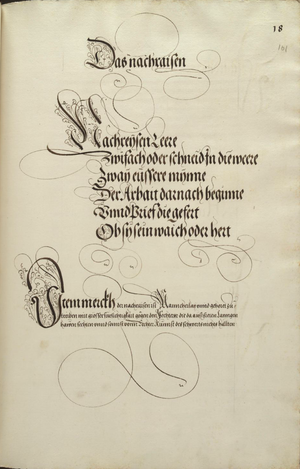|
|
You are not currently logged in. Are you accessing the unsecure (http) portal? Click here to switch to the secure portal. |
Difference between revisions of "User:Kendra Brown/Latin Lew/91v"
Jump to navigation
Jump to search
Kendra Brown (talk | contribs) |
Kendra Brown (talk | contribs) |
||
| Line 122: | Line 122: | ||
# YOU, however, would overtake by hitting his strike, | # YOU, however, would overtake by hitting his strike, | ||
# when therefore HE quickly raises his sword back, | # when therefore HE quickly raises his sword back, | ||
| − | # and | + | # and intercepts your forward attack, |
# strongly then your long edge, | # strongly then your long edge, | ||
# remains bound to his sword, | # remains bound to his sword, | ||
Revision as of 19:34, 14 December 2021
Munich 91v / PDF page 28
Contents
Missing zettel verses from PHM Dresden 101r (Dresden PDF page 39)
Zettel lines 76-77 German
Das nachraisen
- Nachreysen Leere
- Zwifach oder schneid In die weere
- Zway eussere mÿnne
- Der Arbait darnach beginne
- Vnnd Prief die gefert
- Ob sy sein waich oder hert
Zettel lines 76-77 English (Fritz)
The chasing after
- Learn Nachreissen:
- Twice or cut into the the weapon.
- Strive for two outer ones,
- begin your work afterwards.
- Test the passage of arms
- whether they are soft or hard.
91v a
91v a Latin (Sandbox)
- RATIO URGENDI HOStem
- insequendo progressu.
- ISTIUS rationis varij sunt habitus et Usus,
- ijque sunt magna prudentia exercendi atque industria contra Athletas,
- qui ex porrectis et liberis Ictibus Athleticam tractant,
- sed veram ipsius Athleticae artem,
- occultamque non magnifaciunt.
91v a English (Sandbox)
- Method for attacking the enemy
- having advanced to overtake.
- The condition and Use of these methods are diverse,
- and they are to be practiced with great skill and industriousness against Athletes,
- who draw from the extended and free Athletic Strikes,
- but truly the art of Athletics itself,
- And they do not make concealment great.
91v a notes
- confusing habitus in line 3 ("condition")
91v b
91v b Latin (Sandbox)
- Primum habitum rationis hostem urgendi hoc modo exerceto,
- si ad hostem gladiando perveneris,
- sinistrum pedem praeponas,
- teque in custodiam de die componas,
- diligenter autem observes,
- quibus contra te habitus utatur,
- et si eveniat,
- ut porrectim superné contra te feriat de humero suo dextro,
- eum impetum non repellas,
- sed cura ne ictu te apprehendat adversarius,
- atque dum ensis eius in ipsa ictus vi deorsum defertur humum versus,
- ad eum dextro pede prosilias,
- et proximam nuditatem lateris dextri superné quasses,
- et ea ratione priusquam hostis ensem sustulerit,
- iam vulneratus est.
91v b English (Sandbox)
- Exercise the first gesture of the method of pressing the opponent hard in this way,
- if you come up to the opponent ,
- you would place your left foot in front,
- and would collect yourself in the guard of the day,
- but you would observe more diligently,
- the gesture that is used against you by anyone,
- and if it happens,
- in order that he would strike against you extended above from his upper right shoulder
- you do not thrust back his forward attack,
- but undertake that the adversary not seize you with the strike,
- and while his sword would bear down in those strikes with strength, having been overthrown to the ground,
- you would rush toward him with the right foot,
- and batter the closest opening on the left side from above,
- and by means of this method, before the enemy would have lifted the sword,
- soon he is/will have been wounded.
91v b notes
91v c
91v c Latin (Sandbox)
- ALIUS PRECEDENTIS HABITUS.
- QUUM adversarius ictum longius deorsum direxerit,
- hoc autem fiet,
- si eum tu non exceperis,
- ictus .n.[^1] eo modo defertur:
- tu autem eius ictum feriundo consequutus sis,
- cum igitur celeriter is ensem rursus elevet,
- tuumque impetum excipiat,
- fortiter tunc acies ensis tui longa,
- ipsius ensi adiuncta remaneat,
- et si removere sursum conabitur,
- tum dextro hostis pedi sinistrum resiliendo postponas,
- atque transversario vel alio habitu caput ipsius de latere capitis dextro quassabis,
- inde vero celeriter versus alterum latus habitu duplationis seu alio genere ictus laborabis,
- iuxta observationem,[^2]
- num fortiter ensem,
- vel minus, teneat,
- atque haec forma dicitur externa.
91v c English (Sandbox)
- Another of the preceding gesture
- When the adversary directs the longer strike downwards,
- this will take place,
- if YOU do not take it out,
- the strike flows down indeed in that same way:
- YOU, however, would overtake by hitting his strike,
- when therefore HE quickly raises his sword back,
- and intercepts your forward attack,
- strongly then your long edge,
- remains bound to his sword,
- and if he tries to shift upwards,
- then, springing back, you place the left after the right foot of the enemy,
- and by transversing or with another method, you will batter his head from the right side of the head,
- thence truly you will work quickly against the other side using an action of doubling or elsewhere to generate a strike,
- during close observation,
- now he holds the sword strongly,
- or less [so],
- and this is called the outward form.
91v c notes
- [^1]: Enim, according to Cappelli. Also appears on PDF page 11, where we thought it might introduce an editorial comment.
- [^2]: Both accusative

